Table of Contents
Understanding the Impact of Smile Anxiety on Your Daily Life
Smile anxiety can have a significant impact on your daily life, affecting both your physical and psychological well-being. This condition, also known as dental anxiety or dental phobia, is characterized by a fear or unease when it comes to dental procedures, oral health, or even simply smiling. The consequences of smile anxiety can be far-reaching, influencing various aspects of your life such as your social interactions, self-esteem, and overall quality of life.
One of the most apparent effects of smile anxiety is the avoidance of dental appointments and necessary oral health care. Individuals who experience this anxiety may put off routine check-ups, cleanings, and even necessary dental treatments, leading to a decline in oral health. This can result in dental problems worsening over time, leading to more complex and expensive procedures in the long run. Additionally, the fear and unease associated with smile anxiety can cause individuals to feel self-conscious about their smile, leading to a reluctance to engage in social situations or hiding their teeth when interacting with others. As a result, relationships, professional opportunities, and overall confidence can be negatively impacted.
Understanding the impact of smile anxiety is crucial in order to recognize the need for intervention and support. By acknowledging the far-reaching consequences of this condition, individuals can take proactive steps towards overcoming their anxieties and regaining control over their oral health and quality of life. In the following sections of this article, we will explore the root causes, psychological effects, physical consequences, signs and symptoms, and various strategies for managing and overcoming smile anxiety.

Identifying the Root Causes of Smile Anxiety
Identifying the Root Causes of Smile Anxiety
Smile anxiety, also known as dental phobia or odontophobia, is a condition that affects a significant number of individuals worldwide. To effectively address this issue, it is crucial to understand the underlying causes that contribute to the development of smile anxiety. While the specific triggers may vary from person to person, several common root causes have been identified.
One of the primary reasons for smile anxiety is a previous traumatic dental experience. Negative encounters during childhood, such as painful treatments or unsympathetic dental professionals, can leave a lasting impact on an individual’s perception of dental care. These experiences can lead to fear and anxiety around dental visits, which may manifest as smile anxiety in adulthood. Additionally, individuals who have had unpleasant or complicated dental procedures in the past may develop apprehension and anxiety related to future dental care.
Another significant factor contributing to smile anxiety is the fear of pain. Many people associate dental procedures with discomfort or pain, causing them to anticipate similar experiences in the future. This fear can be exacerbated by witnessing or hearing about others’ painful dental experiences, further reinforcing the negative association with dental care. Additionally, the fear of needles, injections, or the sound of dental tools can contribute to anxiety during dental visits, making it more challenging for individuals to relax and feel at ease.
By identifying the root causes of smile anxiety, dental professionals can tailor their approach to address these specific concerns. Understanding the individual’s past traumatic experiences and addressing their fear of pain can help create a more supportive and comforting environment for patients. Additionally, open communication, patient education, and the integration of relaxation techniques can play a vital role in alleviating smile anxiety and promoting positive dental experiences.
Exploring the Psychological Effects of Smile Anxiety
Exploring the Psychological Effects of Smile Anxiety
When it comes to smile anxiety, the psychological impact cannot be underestimated. Individuals who experience smile anxiety often endure a range of negative emotions, such as shame, embarrassment, and self-consciousness. These emotional responses can significantly impact their overall mental well-being and affect various aspects of their daily lives.
One of the most prevalent psychological effects of smile anxiety is a decrease in self-esteem and self-confidence. The constant worry and fear of judgment from others due to their smile imperfections can erode an individual’s sense of self-worth. This can result in decreased social interactions, avoiding social situations altogether, and a generalized sense of inadequacy. Additionally, smile anxiety can trigger feelings of helplessness and frustration, as individuals may feel trapped by their perceived flaws and unable to fully express themselves without the fear of negative judgment.

The psychological effects of smile anxiety can also extend beyond interpersonal relationships. Studies have shown that individuals with smile anxiety may experience higher levels of stress and anxiety in various aspects of their lives. For example, they may feel anxious before job interviews, social gatherings, or even simple daily interactions. This constant state of heightened anxiety can lead to decreased productivity, difficulty concentrating, and a diminished quality of life.
In conclusion, the psychological effects of smile anxiety can be profound and far-reaching. The negative emotions and decreased self-esteem that accompany this condition can impact an individual’s overall mental well-being and hinder their ability to fully engage in social and professional aspects of life. It is crucial to recognize and address the psychological impact of smile anxiety in order to break free from its grip and regain confidence and self-assurance.
Examining the Physical Consequences of Smile Anxiety
Examining the Physical Consequences of Smile Anxiety
Smile anxiety can have significant physical consequences that not only affect our oral health, but also our overall well-being. One of the most common physical manifestations of smile anxiety is teeth grinding or bruxism. Often a subconscious behavior, teeth grinding can occur during the day or while we sleep, putting excessive pressure on our teeth and causing them to wear down over time. This can lead to tooth sensitivity, cracked teeth, jaw pain, and even headaches.
Additionally, smile anxiety can also lead to poor oral hygiene habits. Individuals who experience smile anxiety may avoid regular brushing and flossing due to their fears and insecurities. This can result in a build-up of plaque, tooth decay, and gum disease, which can further worsen their smile anxiety. It becomes a vicious cycle, where the physical consequences of smile anxiety contribute to the anxiety itself.
It is crucial to address the physical consequences of smile anxiety to prevent further damage to our oral health. Through understanding the impact of smile anxiety and identifying the root causes, we can take steps to overcome our fears and build a healthier, more confident smile. In the following sections, we will explore strategies for recognizing the signs and symptoms of smile anxiety, as well as discuss the role of therapists and counselors in addressing this issue. Together, we can overcome smile anxiety and restore our dental health and overall well-being.
Recognizing the Signs and Symptoms of Smile Anxiety
Recognizing the Signs and Symptoms of Smile Anxiety
Smile anxiety, also known as dental phobia or odontophobia, is a condition that can have a significant impact on an individual’s daily life. By understanding the signs and symptoms associated with this condition, individuals can take proactive steps towards seeking the necessary help and support.
One common sign of smile anxiety is an overwhelming fear or apprehension about visiting the dentist. This fear often stems from previous negative experiences or the anticipation of pain. Individuals with smile anxiety may experience a racing heartbeat, sweating, and difficulty breathing when faced with the idea of a dental appointment. Additionally, they may go to great lengths to avoid dental visits altogether, which can lead to the neglect of oral health and the development of more serious dental issues.
| Signs and Symptoms of Smile Anxiety | Description |
|---|---|
| Avoiding Smiling in Public | Individuals may refrain from smiling in social situations. |
| Covering Mouth While Smiling | People might cover their mouths while smiling or laughing. |
| Self-Consciousness about Teeth | Concerns about tooth appearance or alignment. |
| Fear of Judgment | Fear of being judged negatively for their smile. |
| Social Withdrawal | Avoiding social situations or interactions due to anxiety. |
| Low Self-Esteem | Feeling insecure about one’s smile and appearance. |
| Difficulty Maintaining Eye Contact | Avoiding eye contact when smiling due to discomfort. |
| Physical Symptoms (e.g., sweating) | Experience physical symptoms like sweating or shaking. |
| Perfectionism | Striving for a perfect smile, which can lead to stress. |
Overcoming Self-Doubt: Building Confidence in Your Smile
Building confidence in your smile is a crucial step towards overcoming self-doubt and embracing a positive self-image. When we feel self-conscious about our smiles, it can have a profound impact on our overall self-esteem and how we interact with others. Fortunately, there are several strategies that can help us regain confidence in our smiles and break free from the grip of self-doubt.
First and foremost, it’s important to address any underlying dental issues that may be causing our self-doubt. Whether it’s crooked teeth, discoloration, or missing teeth, consulting with a dentist who specializes in cosmetic dentistry can provide valuable insights and options for improving our smiles. From teeth whitening treatments to dental implants, these professionals can tailor a plan to meet our specific needs and goals. By taking proactive steps to improve the appearance of our smiles, we can boost our confidence and feel more comfortable in social situations.
Seeking Professional Help: The Role of Therapists and Counselors
Seeking professional help is a crucial step in overcoming smile anxiety and building confidence in your smile. Therapists and counselors play a vital role in helping individuals navigate the psychological and emotional aspects of this condition. They provide a safe and supportive environment for individuals to explore their fears, insecurities, and negative thought patterns related to their smile.
Therapists and counselors are trained in various therapeutic techniques and strategies that can help individuals develop coping mechanisms, challenge negative thoughts, and promote positive self-image. Through individual counseling sessions, they can help individuals gain insight into the root causes of their smile anxiety and develop personalized treatment plans. Additionally, group therapy sessions may be beneficial, as they provide an opportunity for individuals to connect with others who share similar experiences and offer support and encouragement.
By working with therapists and counselors, individuals can learn effective strategies to manage their smile anxiety and improve their overall well-being. It is important to remember that seeking professional help is not a sign of weakness but a proactive step towards achieving a happier and more confident smile.

The Power of Positive Affirmations in Overcoming Smile Anxiety
Positive affirmations have long been recognized as a powerful tool in overcoming smile anxiety. By practicing self-affirmation techniques, individuals can begin to reshape their perception of their own smile, boosting confidence and reducing anxiety. Affirmations are positive statements that are repeated regularly, serving as a means to reprogram the subconscious mind and remove negative self-perceptions.
One of the key benefits of positive affirmations is their ability to challenge and replace negative thoughts and beliefs. When individuals consistently repeat affirmations such as “I have a beautiful smile” or “My smile radiates confidence,” they begin to internalize these positive messages and gradually let go of self-doubt. Research has shown that regular affirmation practice can not only improve self-image but also enhance overall well-being and mental health. By actively engaging in positive self-talk and reinforcing positive beliefs about their smiles, individuals can gain a sense of empowerment and transform their anxiety into self-assurance.
Practicing Mindfulness: Techniques to Reduce Anxiety in Social Situations
Practicing mindfulness is a powerful technique that can help reduce anxiety in social situations. By bringing our attention to the present moment, mindfulness allows us to observe our thoughts and emotions without judgment, creating a space for self-awareness and self-compassion. This can be particularly helpful when faced with challenging social interactions or situations that trigger smile anxiety.
One effective mindfulness technique is deep breathing. Taking slow, deep breaths can activate the body’s relaxation response, calming the nervous system and reducing anxiety. By focusing on the sensation of the breath entering and leaving the body, we can anchor ourselves in the present moment, redirecting our attention away from anxious thoughts. Pair this deep breathing with a positive mantra or affirmation, such as “I am calm and confident,” to further cultivate a sense of inner peace and reassurance.
Another helpful technique is grounding. When we feel anxious in social situations, our minds often wander to worst-case scenarios or self-critical thoughts. Grounding techniques involve connecting with our physical surroundings to bring our attention back to the present moment. One simple grounding exercise is to notice five things you can see, four things you can touch, three things you can hear, two things you can smell, and one thing you can taste. This sensory engagement can help shift our focus away from anxiety and towards the present, allowing us to fully engage with the people and experiences around us.
By incorporating mindfulness techniques like deep breathing and grounding into our daily lives, we can begin to reduce anxiety in social situations. Practicing mindfulness regularly can help build our resilience and increase our confidence in navigating social interactions. Remember, it takes time and patience to cultivate mindfulness skills, so be kind to yourself and trust in the process.
| Technique | Description |
|---|---|
| Mindful Breathing | Focus on your breath, inhaling and exhaling slowly. This helps calm the nervous system and brings awareness to the present moment. |
| Body Scan | Conduct a mental scan of your body from head to toe, noticing any tension or discomfort. By acknowledging these sensations, you can release them and relax more fully. |
| Grounding Techniques | Use grounding techniques such as feeling the sensation of your feet on the ground or observing the environment around you to anchor yourself in the present moment. |
| Non-Judgmental Awareness | Practice observing your thoughts and feelings without judgment. Recognize that it’s natural to feel anxious in social situations and allow yourself to experience these emotions. |
| Gratitude Practice | Cultivate gratitude by reflecting on things you’re thankful for. This shifts your focus from anxiety to positive aspects of your life, promoting a sense of well-being and calmness. |
| Loving-Kindness Meditation | Engage in loving-kindness meditation, directing feelings of love and compassion towards yourself and others. This fosters a sense of connection and reduces self-consciousness. |
| Progressive Muscle Relaxation | systematically tense and then relax each muscle group in your body, starting from your toes and working your way up to your head. This helps release physical tension and promotes relaxation. |
Gradual Exposure Therapy: Confronting Smile Anxiety Step by Step
Gradual exposure therapy is a widely recognized and effective technique for managing smile anxiety. By systematically and gradually exposing individuals to anxiety-provoking situations, this therapy helps them confront their fears and build resilience over time. The concept behind gradual exposure therapy is rooted in the understanding that avoidance only reinforces anxiety, while confronting fears directly can lead to desensitization and increased confidence.
During gradual exposure therapy, individuals work closely with a qualified therapist who guides them through a step-by-step process. Starting with less intimidating situations, such as being in a group setting with familiar faces, they gradually progress to more challenging scenarios, such as engaging in conversations with strangers or participating in public speaking events. This systematic approach allows individuals to confront their fears in a controlled environment and develop healthy coping mechanisms for managing anxiety. The therapist provides support, encouragement, and guidance throughout the process, ensuring that patients feel safe and supported as they face their fears.
Through gradual exposure therapy, individuals with smile anxiety can gain a greater sense of control over their emotions and responses. As they confront their fears head-on, they may experience a reduction in anxiety symptoms and an increase in self-confidence. Furthermore, this therapy can help individuals develop long-lasting strategies for managing anxiety in various social situations, enabling them to lead a more fulfilling and authentic life.
Utilizing Cognitive-Behavioral Techniques to Challenge Negative Thoughts
Challenging negative thoughts is a crucial aspect of utilizing cognitive-behavioral techniques in overcoming smile anxiety. Our thoughts have a powerful impact on our emotions and behaviors, and negative thought patterns can exacerbate feelings of self-doubt and anxiety about our smiles. By identifying and challenging these negative thoughts, we can reframe our perspectives and build a healthier self-image.
One effective technique is cognitive restructuring, which involves examining the evidence for and against negative thoughts related to our smiles. For example, if you find yourself having thoughts like “My smile is ugly,” challenge this belief by gathering evidence to the contrary. Look at old photographs where you genuinely smiled and received positive feedback. By objectively evaluating the evidence, you can begin to shift your perspective and challenge those negative thoughts that undermine your confidence.
Another helpful strategy is thought stopping, a technique that involves interrupting negative thought patterns and replacing them with positive or neutral thoughts. When you catch yourself dwelling on a negative thought about your smile, mentally shout “Stop!” and divert your attention to a positive affirmation or a pleasant memory. Over time, these intentional interruptions can weaken the grip of negative thoughts and help you cultivate a more optimistic view of your smile.
It’s important to remember that changing negative thought patterns takes time and practice. Consistency is key, so be patient with yourself as you work towards challenging and replacing those negative thoughts. With dedication and the guidance of a trained professional, you can develop healthier cognitive patterns and reclaim your confidence in your smile.
Developing Healthy Coping Mechanisms for Smile Anxiety
Developing healthy coping mechanisms is crucial for individuals dealing with smile anxiety. These coping strategies can help individuals navigate social situations, improve self-confidence, and ultimately, reduce the impact of smile anxiety on their daily lives.
One effective coping mechanism is practicing relaxation techniques. Deep breathing exercises, meditation, and progressive muscle relaxation can help individuals manage their anxiety and promote a sense of calmness. By incorporating these techniques into their daily routines, individuals can reduce stress levels and approach social situations with a greater sense of ease.
In addition, it can be helpful to challenge negative thoughts and beliefs associated with smile anxiety. Cognitive-behavioral techniques, such as reframing negative thoughts and focusing on positive aspects of oneself, can lead to a more positive outlook and improve self-esteem. Seeking support from friends, family, or a therapist can provide valuable guidance and encouragement throughout this process.
Overall, developing healthy coping mechanisms is essential for individuals struggling with smile anxiety. By practicing relaxation techniques and challenging negative thoughts, individuals can take control of their anxiety and foster a positive self-image.
The Importance of a Support System in Overcoming Smile Anxiety
A strong support system plays a crucial role in overcoming smile anxiety and regaining confidence in one’s appearance. Having a supportive network of family, friends, and healthcare professionals can provide the emotional support, encouragement, and guidance needed throughout the journey of overcoming smile anxiety. It is important to surround oneself with individuals who understand and empathize with the challenges faced, as their understanding and encouragement can be instrumental in boosting one’s self-esteem.
The support system can offer a safe space to share fears, insecurities, and concerns, and act as a sounding board for exploring potential solutions. Their presence and understanding can help alleviate the feelings of isolation and self-doubt that often accompany smile anxiety. Additionally, loved ones can provide reassurance and positive affirmation, reminding individuals of their worth beyond their physical appearance.
Furthermore, healthcare professionals, such as therapists and counselors, can offer specialized guidance tailored to individual needs. With their expertise in addressing psychological and emotional challenges, these professionals can provide tools and strategies to manage anxiety and build resilience. Seeking professional help can empower individuals with a deeper understanding of the root causes of smile anxiety and equip them with the necessary skills to confront and overcome these challenges effectively.
In conclusion, the support system plays a vital role in overcoming smile anxiety. The emotional support, understanding, and guidance offered by loved ones and healthcare professionals can provide reassurance, boost self-esteem, and equip individuals with the necessary tools to confront and manage smile anxiety effectively. By building a strong support network, individuals can regain their confidence and embrace their true beauty beyond their physical appearance.
Nurturing Self-Care: Incorporating Relaxation Techniques into Your Routine
Self-care plays a crucial role in maintaining our overall well-being, and incorporating relaxation techniques into our daily routine can have a significant impact on reducing smile anxiety. Taking the time to prioritize self-care allows us to nurture not only our physical health but also our mental and emotional well-being. By intentionally engaging in relaxation techniques, we can create a space for relaxation and rejuvenation, helping to alleviate the stress and anxiety often associated with smile anxiety.
One effective relaxation technique for managing smile anxiety is deep breathing exercises. Deep breathing activates the body’s relaxation response and helps reduce feelings of tension and anxiety. By focusing on our breath and taking slow, deep inhales and exhales, we can calm our nervous system and promote a sense of calm and relaxation. Practicing deep breathing regularly can also help improve overall dental health by reducing the effects of stress and tension on our oral cavity.
Another helpful relaxation technique is progressive muscle relaxation. This involves systematically tensing and then releasing different muscle groups in the body, which helps to release built-up tension and promote a sense of relaxation. By consciously tensing and then relaxing each muscle group, we can become more aware of tension residing in our bodies and actively work towards releasing it. Incorporating progressive muscle relaxation into our daily routine can not only help reduce smile anxiety but also improve our overall physical and mental well-being.
Incorporating relaxation techniques into our daily routine is a powerful way to nurture self-care and manage smile anxiety. By dedicating time to engage in deep breathing exercises and progressive muscle relaxation, we can create a sense of calm and relaxation in our daily lives. These techniques not only alleviate the stress and tension associated with smile anxiety but also contribute to overall physical and mental health. Prioritizing self-care through relaxation techniques is an essential step towards overcoming smile anxiety and fostering a positive and confident smile.
Embracing Imperfections: Redefining Beauty Standards and Self-Image
Embracing Imperfections: Redefining Beauty Standards and Self-Image
In a society that often sets unrealistic beauty standards, it’s crucial to redefine our perception of perfection. Embracing our imperfections is not only a powerful act of self-acceptance, but also a means to challenge the narrow ideals we are bombarded with on a daily basis.
Firstly, it’s important to understand that beauty comes in all shapes, sizes, and forms. Each individual is unique, with their own distinctive features and qualities. Rather than striving to fit into a mold, we should celebrate our individuality and embrace the qualities that make us truly authentic. As the author Steve Maraboli once said, “There is nothing more rare, nor more beautiful, than a woman being unapologetically herself; comfortable in her perfect imperfection. To me, that is the true essence of beauty.”
By redefining beauty standards and embracing our imperfections, we can cultivate a healthier self-image. This shift in mindset allows us to focus on our inner qualities and strengths, rather than fixating on external appearances. Ultimately, our self-worth should not be dictated by societal norms, but rather by our own self-acceptance and confidence in who we are. So let us embrace our imperfections and rewrite the narrative of beauty, creating a world where authenticity and self-love reign supreme.
(Word count: 182)
Celebrating Progress: Maintaining a Positive Outlook on Your Journey to Overcome Smile Anxiety
Maintaining a positive outlook on your journey to overcome smile anxiety is crucial for your progress and overall well-being. Celebrating each milestone and recognizing your achievements is an important part of this process. By acknowledging your efforts and growth, you can fuel yourself with motivation and continue moving forward.
One way to maintain a positive outlook is to set realistic goals for yourself. Breaking down your journey into smaller, achievable steps allows you to track your progress and experience a sense of accomplishment along the way. Whether it’s practicing a new dental hygiene routine or gradually exposing yourself to social situations that trigger your smile anxiety, each small step forward is worth celebrating.
Additionally, surrounding yourself with a support system can provide an invaluable source of encouragement and validation. Family, friends, or even support groups can offer a listening ear, advice, and reassurance during challenging times. Sharing your successes and setbacks with understanding individuals who truly care about your well-being can significantly contribute to your positive outlook and ultimate triumph over smile anxiety.
Remember, the journey to overcome smile anxiety is a personal one, and progress may not always be linear. Embrace the ups and downs, and celebrate every milestone as a testament to your strength and resilience. With a positive mindset and a supportive network, you can continue to make progress and reclaim your confidence in your smile.
What is smile anxiety?
Smile anxiety refers to a condition where individuals feel a significant amount of distress, self-consciousness, and fear when it comes to their smile. It can affect a person’s daily life and interactions with others.
What are some common signs and symptoms of smile anxiety?
Some common signs and symptoms of smile anxiety include avoiding smiling or covering one’s mouth when smiling, feeling embarrassed or self-conscious about the appearance of their teeth, experiencing anxiety or nervousness in social situations that involve smiling, and having low self-esteem related to their smile.
What are the root causes of smile anxiety?
Smile anxiety can stem from various factors, including past negative experiences related to the appearance of one’s teeth, societal beauty standards and pressures, bullying or teasing about one’s smile, and underlying mental health issues such as social anxiety disorder or body dysmorphic disorder.
How can positive affirmations help in overcoming smile anxiety?
Positive affirmations involve consciously challenging and replacing negative thoughts with positive and empowering ones. By repeating affirmations focused on self-acceptance, self-love, and embracing imperfections, individuals can gradually build confidence in their smile and reduce anxiety associated with it.
What is gradual exposure therapy, and how can it help in confronting smile anxiety?
Gradual exposure therapy is a technique that involves gradually and repeatedly exposing oneself to situations that trigger anxiety or discomfort. In the context of smile anxiety, it would involve incrementally facing and engaging in smiling situations, allowing individuals to build resilience and reduce their anxiety over time.
How can developing healthy coping mechanisms help in managing smile anxiety?
Developing healthy coping mechanisms involves finding constructive ways to deal with and alleviate anxiety related to smile anxiety. Techniques such as deep breathing exercises, journaling, engaging in hobbies or activities that bring joy, and seeking support from loved ones can all contribute to managing and reducing smile anxiety.
Why is having a support system important in overcoming smile anxiety?
Having a support system can provide individuals with emotional support, understanding, and encouragement throughout their journey to overcome smile anxiety. Trusted friends, family members, or support groups can offer a safe space to express feelings, share experiences, and receive validation, which can be instrumental in building resilience and self-confidence.
How can practicing mindfulness help in reducing anxiety in social situations related to smile anxiety?
Mindfulness techniques involve focusing one’s attention on the present moment without judgment. By practicing mindfulness, individuals can become more aware of their anxious thoughts and physical sensations, allowing them to respond with greater control and calmness in social situations that trigger smile anxiety.
How can therapists and counselors help in overcoming smile anxiety?
Therapists and counselors with expertise in anxiety disorders can provide guidance, support, and evidence-based techniques to help individuals overcome smile anxiety. They can offer a safe and non-judgmental space to explore the root causes of the anxiety, develop coping strategies, and work towards developing a healthier mindset and increased self-confidence.












